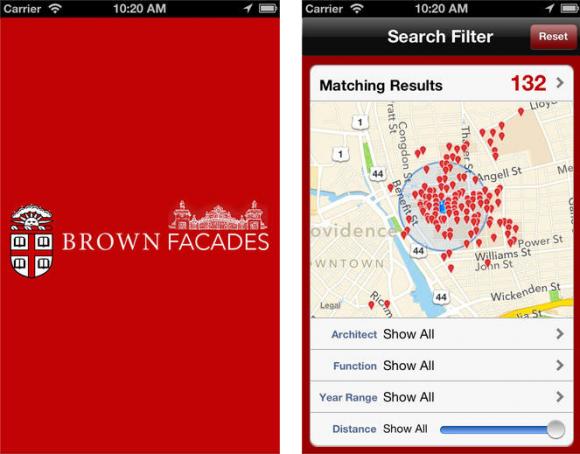PROVIDENCE, R.I. [Brown University] — Even the most casual observer strolling across campus can’t miss the impressive mix of architecture that dots the landscape, from regal old stone buildings to sleek glass and metal structures. But harder to come by, without doing some serious research, are the stories behind each of those buildings. Now a newly launched iPhone app, built on work by Brown students in a 2011 architectural history class, makes finding those stories much easier.
Brown FACADES is an interactive guide to the architectural history of campus, currently available for free on the AppStore, with information on 130 buildings, both old and new.
Users can search for buildings by architect, function, year, or distance. The app’s GPS function guides users to each building and a text-to-speech function allows users to listen to each building’s history as they stand outside, taking note of various architectural elements.
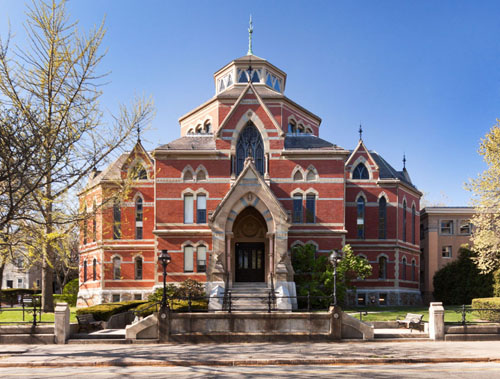
The project began in the fall of 2011 when Dietrich Neumann put students in his seminar class to work researching the histories of buildings around campus with a goal of eventually creating an app with the information.
“I have often taught classes about the architecture of Providence and then had the idea of doing something about our campus. An architecture guide was long needed, and an iPhone app with GPS and a reading function is in some ways an ideal tool for that," said Neumann, who is a professor of the history of modern architecture and urban studies.
Every week during the semester-long seminar, each of the students in Neumann’s class was charged with researching a different building. Using primary sources both on and off campus, including documents available at the Rhode Island Historical Society, the Providence Preservation Society, the Brown University Archives at the John Hay Library, Brown Daily Herald archives and Encyclopedia Brunoniana, they carefully pieced together each structure’s history.
“I think it’s important to understand how history’s traces can be found everywhere and that the local always reflects the national and global history as well,” Neumann said.
Senior Kalen McNamara said working on the project gave her a new lens through which to see the campus. “One of Professor Neumann’s goals was to let Brown students know that there are a lot of beautiful, important buildings on campus with interesting stories that aren’t talked about as much on campus. When people talk about spectacular architecture here, they tend to point to more recent projects, but the class opened my eyes to a lot of other interesting stories.”
Some information, the students quickly found, was not always easy to come by, according to senior Siri Olson.
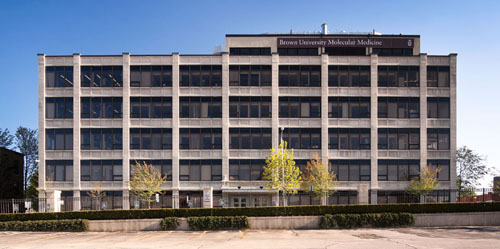
“For a lot of the buildings, there was not a lot of information available, especially the older private homes that Brown has bought over the years and turned into offices,” Olson said. “The lack of information was heartbreaking in a way. We’d have to do some really deep digging, and that was really a challenge.”
Olson became so immersed in the project that she was one of five students who stayed on once the class had ended to help Neumann edit and consolidate the student-authored histories for the app. She eventually became the project’s editor-in-chief.
“Being an architectural studies concentrator, I’m particularly partial to buildings and I thought when I was doing all of the research for the class that it was a really interesting experience that allowed me to see campus in a whole different way,” Olson said. “I learned things about buildings that I would walk past every day and never think about.”
Olson said her research revealed a number of surprising facts, including that Andrews House, which currently houses Health Services, was once the home of Rhode Island Gov. R. Livingston Beekman.
“It’s a little funny that you go in there thinking ‘I feel so sick,’ but this is where the governor once held elegant dinner parties,” Olson said.
McNamara said the project gave her architectural studies concentration new direction. “It was the experiences I had in that class that sparked my interest in adaptive re-use. I think it’s a good policy here at Brown that isn’t celebrated often enough. I think my favorite example of that on campus is Rhode Island Hall. It’s so gorgeous.”
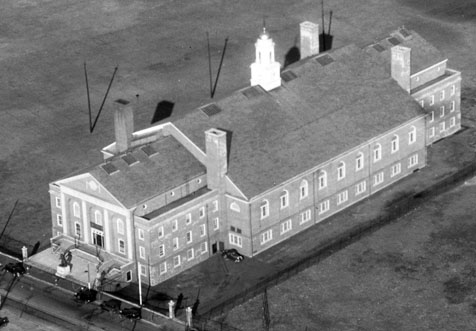
Once the research portion of the project was completed, Neumann enlisted some outside help to assist with creating the finished product. He hired architectural photographer Hassan Bagheri to capture images of the buildings and Montreal-based Gokce Kinayoglu to do the programming.
In addition to their weekly research projects, the class got a chance to explore some lesser known parts of campus. Each week, Neumann would send out an e-mail right before class announcing where to meet. Gathering spots included the Ladd Observatory and the University’s central heating plant. It was a way for the students to “learn about the countless hidden treasures on our campus,” said Neumann.
One of Olson’s favorite meeting spots was the seminar room in the Applied Mathematics building on George Street.
“They have these beautiful stained glass windows in there, and you’d never know unless you made a point to go in there,” Olson said. “That’s what I really like about the app: It has all these little details like the windows that you might never know and might never get a chance to see unless you make a point of finding out about them or just stumble across them.”
Neumann said one of the most interesting features of FACADES is the “ghost buildings” — structures that once existed but were torn down or projects that were planned but never built.
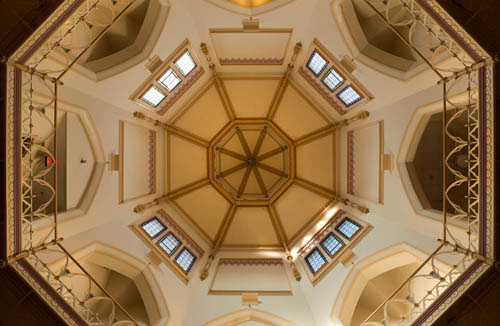
“I’m very fond and proud of this feature. The ghost buildings tell an alternative history, in a way,” Neumann said.
Buildings in that category include the former University President’s house, which stood on the corner of Prospect and College streets, Candela Atheltic Complex, and Marvel Gymnasium.
Neumann said he hopes FACADES eventually becomes the go-to resource for students, alumni, and other campus visitors who want to know more about the history of Brown’s buildings. Neumann is hoping to lead another class to expand the app’s content, adding stories to existing histories and continuing to add more buildings to the list. An iPad version will launch in December and an Android version will be released with a major update in the coming months.
The app can be downloaded for free from the iTunes Store.
Reflecting on the now two-year-old project, McNamara said she has a new appreciation for Brown’s campus. “I realized that what makes an Ivy League university so appealing and such a draw to students is its architecture. You don’t think about it much, but there really is a unique campus feel.”

